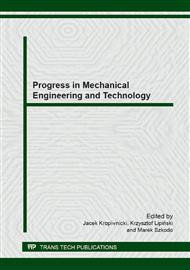p.119
p.125
p.131
p.137
p.145
p.153
p.159
p.165
p.171
Numerical Comparison of Damping Amplification Effects Obtained in Neighbourhood of a Mechanism's Singular Position - Viscous and Electromagnetic Cases
Abstract:
In the paper, effects of numerical investigations are presented. Vibrations of mechanical and electromechanical systems are considered and compared. In the system, a continuous beam is considered as the main vibrating element. Two energy dissipations methods are compared: viscous dampers and DC generators. To increase the damping effectiveness, velocity amplification is proposed, i.e., a mechanism is introduced between the beam and the damping element, and the mechanism configuration is set as closed to the singular position of it. According to some observed fundamental differences in the guiding physical properties of some blocks present in the considered system, two structurally different sub-models are introduced in the numerical model of the complete system. The first sub-model corresponds to the amplification mechanism (considered as composed of rigid elements). The mechanism is modelled as a multibody system. The second sub-model corresponds to the continuous beam. The beam is modelled with used of the finite elements technique. To joint the sub-models, constraint equations are proposed. They express a revolute joint that is present between the mechanisms second rod and the beam enforced to vibrate.
Info:
Periodical:
Pages:
145-150
Citation:
Online since:
December 2013
Authors:
Price:
Сopyright:
© 2014 Trans Tech Publications Ltd. All Rights Reserved
Share:
Citation:


